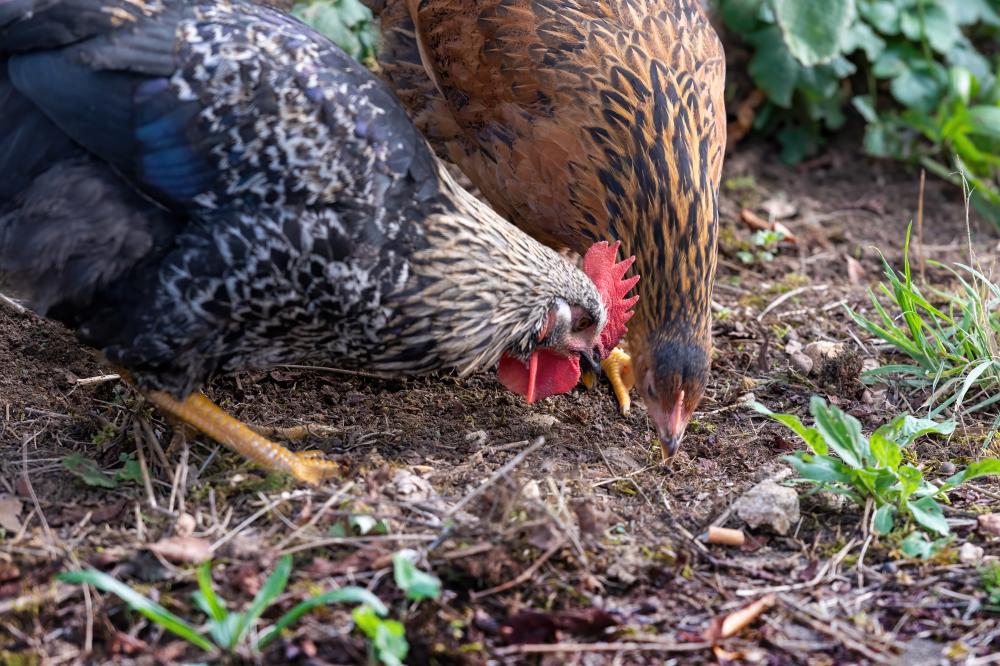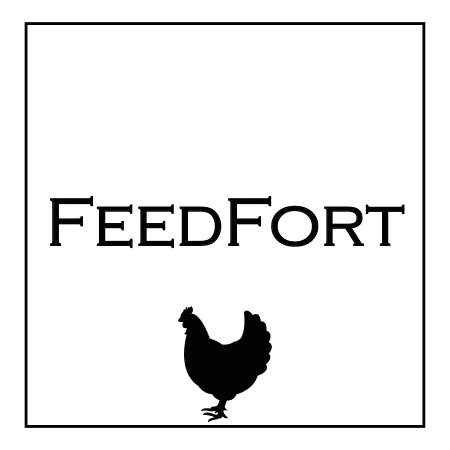Automatic Bird Feeder

Why Choose an Automatic Bird Feeder?
Embracing the dawn chorus as you step into the garden, scattering feed as a morning ritual, is a scene many chicken owners cherish. Yet, in the hustle and bustle of life, consistency in this routine can falter. This is where the magic of an Automatic Bird Feeder, such as the ones we proudly produce at FeedFort, enters. Our feeders aren’t just about convenience; they’re about providing peace of mind and security for your cherished flock.
Our Automatic Bird Feeder, made from sturdy American-made 5052 Aluminum, promises durability and reliability. But what truly sets it apart is its patented photocell technology. As light fades and dawn breaks, our feeders swing into action, ensuring your chickens receive their meals exactly when they should, without fail, eliminating the worry of overfeeding or underfeeding.
What’s more, our design significantly reduces the risk of unwanted guests. Rodents, a common thorn in the side of poultry keepers, are ingeniously kept at bay, preserving the hygiene of your coop and the health of your flock. By incorporating an automatic feeder into your care routine, you’re not just feeding chickens; you’re elevating their living conditions.
How Does Our Automatic Bird Feeder Work?
Photocell Technology
The core of FeedFort’s operation lies in its innovative use of photocell technology. This isn’t merely a fancy term we throw around; it’s the heartbeat of our feeder. As daylight increases, the feeder detects this change and gently opens, allowing your chickens access to their feed without delay. Similarly, as evening approaches and light diminishes, the feeder automatically secures itself, safeguarding your feed from nocturnal pests.
Slow Descent Feature
One might wonder, doesn’t the sudden appearance and disappearance of food stress the birds? Not with our slow descent feature. This carefully designed aspect ensures that the feed is exposed or concealed in a gradual, gentle manner. Chickens are surprisingly fast learners, quickly getting accustomed to this rhythm, ensuring they eat their fill without rush or waste.
Benefits of Choosing FeedFort
Choosing a FeedFort Automatic Bird Feeder isn’t just about what it does; it’s about what it brings to your everyday life. The immediate benefit is, of course, convenience. No longer are you tied to the break of dawn or the setting sun to feed your chickens. This freedom allows you to focus on other aspects of care and, perhaps, even a lie-in on the weekends.
Secondly, the health and safety benefits cannot be overstated. Keeping rodents out means keeping diseases and mites at bay. This isn’t just about avoiding the nuisance of pests; it’s about protecting your flock from diseases that can decimate populations. Our feeders offer a shield against such tragedies, all while ensuring your feed is utilized to its fullest, minimizing waste and saving you money in the long run.
Installation and Maintenance
Easy Installation
The thought of integrating new technology into your coop might seem daunting, but we’ve designed our Automatic Bird Feeder with ease in mind. The installation process is straightforward, requiring no advanced tools or skills. Within minutes, you can have your feeder up and running, ready to serve your flock.
Simple Maintenance
Maintaining your FeedFort feeder is just as easy as installing it. Due to its high-quality construction and materials, the need for frequent repairs or replacements is vastly reduced. A simple check now and then to ensure the feeder is clean and the photocell sensor is unobstructed is all that’s required to keep it in peak condition.
Considerations Before Purchase
While our Automatic Bird Feeder is designed to cater to a broad range of poultry keepers, it’s important to assess your specific needs and conditions before making a purchase. Consider the size of your flock, the layout of your coop, and the typical feeding schedule your birds are accustomed to. Our team at FeedFort is always on hand to advise and ensure that you select the best feeder for your circumstances.
Customer Success Stories
Nothing warms our hearts more than hearing how our Automatic Bird Feeder has simplified the lives of poultry keepers. From small backyard flocks to larger agricultural setups, the feedback has been overwhelmingly positive. Customers often highlight the dramatic reduction in feed waste and the joy of seeing their chickens thrive on a consistent feeding schedule.
Anecdotes of previously persistent rodent problems resolved overnight and stories of healthier, happier birds solidify our belief in the value our feeders bring to the table. It’s these success stories that fuel our passion and drive our ongoing innovations.
Looking Ahead: Future Innovations
At FeedFort, our journey doesn’t stop with the current model of our Automatic Bird Feeder. We’re constantly exploring new technologies, materials, and designs to enhance our offerings. The feedback from our customers plays a crucial role in this process, guiding our developments and ensuring that our future products continue to meet the evolving needs of poultry keepers.
Final Thoughts
Choosing an Automatic Bird Feeder from FeedFort means integrating a piece of innovative, thoughtful technology into your poultry care routine. It means embracing convenience without compromising the health and safety of your flock. As we continue to evolve and expand our offerings, our commitment to quality, reliability, and the well-being of your birds remains steadfast. Welcome to the future of poultry feeding, where convenience and care go hand in hand.

Do birds tell each other where food is?
Indeed, birds have a fascinating way of communicating, especially when it comes to pinpointing sources of food. Many species, like the well-known chickadee, have specific calls to alert others of food discoveries. This communal sharing ensures the survival of the flock, especially in harsh conditions. For us at FeedFort, understanding these natural behaviors inspires the features of our automatic chicken feeders, aiming to complement the birds’ instinctual feeding practices. Have you ever noticed a sudden increase in bird activity around feeding times in your garden? That’s their communication at work.
What happens if I stop feeding birds?
If you’ve been consistently feeding birds and suddenly stop, they might experience initial confusion. Birds are adaptable creatures and will seek out other food sources. However, during critical times such as winter or during breeding seasons when food is scarce, the impact can be more pronounced. Our commitment at FeedFort is to provide a consistent and reliable feeding schedule with our automatic feeders, ensuring that abrupt stoppages in food supply are never a concern for your flock.
How far away from the house should a bird feeder be?
The placement of a bird feeder can greatly influence the safety and accessibility for the birds. Generally, it’s recommended to place feeders about 10 to 12 feet away from structures. This distance helps reduce the risk of birds colliding with windows while also keeping the feeder accessible and visible to you as the observer. With automatic feeders like ours, positioning is also key to ensuring the photocell technology operates optimally, without shadows or artificial light influencing its function.
What is the best homemade bird feeder?
A simple yet effective homemade bird feeder can be created using materials like a plastic bottle or milk carton with holes cut out for access to the seed. These DIY feeders can spark creativity and make wonderful projects for families. However, they might not provide the same level of protection against pests or the elements as more sophisticated solutions like our FeedFort automatic feeders. Always consider the hygiene and safety of your feathered friends when choosing or making a feeder.
What unique benefits does an automatic bird feeder offer?
Our FeedFort automatic bird feeder leverages photocell technology to ensure timely and consistent feed access for your chickens, reducing waste and deterring pests. This automated approach not only simplifies your daily routine but significantly enhances the health and safety of your flock. By minimizing human error and the variability of manual feeding, our feeders deliver peace of mind and operational efficiency–a testament to how technology can beautifully harmonize with nature’s rhythms.
Can the automatic feeder adjust to different feeding schedules?
Absolutely, flexibility is a cornerstone of our FeedFort feeders. While our automatic bird feeders are designed with a default setting that utilizes natural light changes, we understand the necessity for adjustments based on your flock’s specific needs or seasonal changes. Our customer support team is always here to help you tailor the feeding schedule to your particular setup, ensuring your chickens always have access to fresh feed when they need it most.
How do I choose the best automatic feeder for my situation?
Selecting the right feeder involves assessing several factors: the size of your flock, the layout of your coop, and your birds’ feeding habits. Our FeedFort feeders are designed to cater to a wide range of needs, offering durable construction and innovative technology to streamline your feeding process. We recommend reaching out to our knowledgeable team, who can provide personalized advice based on your unique circumstances, ensuring you get the most out of your automatic feeder investment.
Resources
- Food Safety and Inspection Service (FSIS) – The Food Safety and Inspection Service is a public health agency of the U.S. Department of Agriculture. Their website provides information on food safety, including guidelines for handling poultry.
- National Agricultural Statistics Service (NASS) – The National Agricultural Statistics Service provides timely, accurate, and useful statistics in service to U.S. agriculture. Their website offers data on poultry production and trends.
- Animal and Plant Health Inspection Service (APHIS) – The Animal and Plant Health Inspection Service is a multifaceted agency with a broad mission area that includes protecting and promoting U.S. agricultural health. Their website provides information on animal health and disease prevention.

